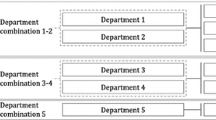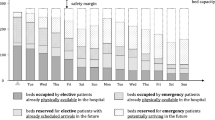Abstract
Effective and efficient care of hospital patients relies on well-coordinated resource allocation. Determining the number of beds and nurses in clinical units depends, among other considerations, on admission volumes, lengths of stay, and staffing availability, all of which are stochastic in practice. Given these uncertainties, this paper develops two robust optimization models to help plan the most effective bed and nurse resource allocation in terms of costs and access in a single clinical unit while allowing resources to be shared between units for flexibility. Ellipsoidal, budgeted, and data-driven formulations are compared for “conservatism," a measure of costs incurred to achieve robustness. In addition to existing formulations we develop uncertainty sets based on least-squares ellipsoidal fitting, which produces better solutions in our application. A case study involving different patient types and care levels reduces the number of patients that cannot be admitted (non-admissions) by up to 85% for the budgeted model and up to 100% for the data-driven model, with resource sharing reducing costs by 1% and 2%, respectively, compared to the non-sharing models. While the least-squares ellipsoidal model increases costs from the current scenario by 2% to achieve robustness, the budgeted and data-driven counterparts increase costs by 54% and 57%, respectively. These results have important implications for how uncertainty sets are formed when applying robust optimization to healthcare problems.




Similar content being viewed by others
References
Bailey, N. T. J. (1954). Queueing for medical care. Applied Statistics, 3(3), 137–145.
Bai, X., Sun, C., & Zhou, F. (2009). Splitting touching cells based on concave points and ellipse fitting. Pattern Recognition, 42(11), 2434–2446. https://doi.org/10.1016/j.patcog.2009.04.003.
Belciug, S., & Gorunescu, F. (2015). Improving hospital bed occupancy and resource utilization through queuing modeling and evolutionary computation. Biomedical Informatics, 53, 261–269.
Beliën, J. (2007). Exact and heuristic methodologies for scheduling in hospitals: Problems, formulations and algorithms. 4OR, 5(2), 157–160. https://doi.org/10.1007/s10288-006-0006-4.
Ben-Tal, A., Den Hertog, D., De Waegenaere, A., Melenberg, B., & Rennen, G. (2013). Robust solutions of optimization problems affected by uncertain probabilities. Management Science, 59(2), 341–357.
Ben-Tal, A., El Ghaoui, L., & Nemirovski, A. (2009). Robust optimization. Princeton University Press.
Ben-Tal, A., Goryashko, A., Guslitzer, E., & Nemirovski, A. (2004). Adjustable robust solutions of uncertain linear programs. Mathematical Programming, 99(2), 351–376.
Ben-Tal, A., & Nemirovski, A. (1998). Robust convex optimization. Mathematics of Operations Research, 23(4), 769–805.
Ben-Tal, A., & Nemirovski, A. (1999). Robust solutions of uncertain linear programs. Operations Research Letters, 25(1), 1–13.
Bertsimas, D., Gupta, V., & Kallus, N. (2014). Data-driven robust optimization. arXiv preprint arXiv:14010212v2.
Bertsimas, D., & Sim, M. (2004). The price of robustness. Operations Research, 52(1), 35–53.
Best, T. J., Sandikci, B., Eisenstein, D. D., & Meltzer, D. O. (2015). Managing hospital inpatient bed capacity through partitioning care into focused wings. Manufacturing & Service Operations Management, 17(2), 157–176. https://doi.org/10.1287/msom.2014.0516.
Bortfeld, T., Chan, T. C. Y., Trofimov, A., & Tsitsiklis, J. N. (2008). Robust management of motion uncertainty in intensity-modulated radiation therapy. Operations Research, 56(6), 1461–1473. https://doi.org/10.1287/opre.1070.0484.
Bretthauer, K. M., & Cote, M. J. (1998). A model for planning resource requirements in health care organizations. Decision Sciences, 29(1), 243–270.
Bureau of Labor Statistics. (2016). Occupational employment and wages, May 2016. https://www.bls.gov/oes/current/oes291141.htm#st.
Carey, K. (1998). Stochastic demand for hospitals and optimizing “excess’’ bed capacity. Journal of Regulatory Economics, 14(2), 165–188.
Cochran, J. K., & Bharti, A. (2006). A multi-stage stochastic methodology for whole hospital bed planning under peak loading. International Journal of Industrial and Systems Engineering, 1(1), 8–36.
Costa, A. X., Ridley, S. A., Shahani, A. K., Harper, P. R., De Senna, V., & Nielsen, M. S. (2003). Mathematical modelling and simulation for planning critical care capacity. Anaesthesia, 58(4), 320–327.
Delage, E., & Ye, Y. (2010). Distributionally robust optimization under moment uncertainty with application to data-driven problems. Operations Research, 58(3), 595–612. https://doi.org/10.1287/opre.1090.0741.
El Ghaoui, L., & Lebret, H. (1997). Robust solutions to least-squares problems with uncertain data. SIAM Journal on Matrix Analysis and Applications, 18(4), 1035–1064.
Halir, R., & Flusser, J. (1998). Numerically stable direct least squares fitting of ellipses. In Proceedings of 6th international conference in central Europe on computer graphics and visualization WSCG 98.
Halpern, N. A., Goldman, D. A., Tan, K. S., & Pastores, S. M. (2016). Trends in critical care beds and use among population groups and medicare and medicaid beneficiaries in the United States: 2000–2010. Critical care medicine, 44(8), 1490–9. https://doi.org/10.1097/CCM.0000000000001722.
Harper, P. R., & Shahani, A. K. (2002). Modelling for the planning and management of bed capacities in hospitals. Journal of the Operational Research Society, 53(1), 11–18.
Kao, E., & Tung, G. (1981a). Aggregate nursing requirement planning in a public health care delivery system. Socio-Economic Planning Sciences, 15(3), 119–127. https://doi.org/10.1016/0038-0121(81)90027-6.
Kao, E., & Tung, G. (1981b). Bed allocation in a public health care delivery system. Management Science, 27(5), 507–520.
Khachiyan, L. G. (1980). Polynomial algorithm in linear programming. USSR Computational Mathematics and Mathematical Physics, 20(1), 53–72.
Kim, S. C., Horowitz, I., Young, K. K., & Buckley, T. A. (1999). Analysis of capacity management of the intensive care unit in a hospital. European Journal of Operational Research, 115(1), 36–46.
Kokangul, A. (2008). A combination of deterministic and stochastic approaches to optimize bed capacity in a hospital unit. Computer Methods and Programs in Biomedicine, 90(1), 56–65.
Kokangul, A., Akcan, S., & Narli, M. (2016). Optimizing nurse capacity in a teaching hospital neonatal intensive care unit. Health Care Management Science. https://doi.org/10.1007/s10729-015-9352-0.
Kouvelis, P., & Yu, G. (1997). Robust discrete optimization and its applications. Boston: Kluwer Academic Publishers.
Maenhout, B., & Vanhoucke, M. (2013). An integrated nurse staffing and scheduling analysis for longer-term nursing staff allocation problems. Omega (United Kingdom), 41(2), 485–499. https://doi.org/10.1016/j.omega.2012.01.002.
Mannino, C., Nilssen, E. J., & Nordlander, T. E. (2012). A pattern based, robust approach to cyclic master surgery scheduling. Journal of Scheduling, 15(5), 553–563. https://doi.org/10.1007/s10951-012-0275-z.
Meng, F., Qi, J., Zhang, M., Ang, J., Chu, S., & Sim, M. (2015). A robust optimization model for managing elective admission in a public hospital. Operations Research, 63(6), 1452–1467. https://doi.org/10.1287/opre.2015.1423.
Mestre, A., Oliveira, M., & Barbosa-Póvoa, A. (2015). Location–allocation approaches for hospital network planning under uncertainty. European Journal of Operational Research, 240(3), 791–806.
Needleman, J., Buerhaus, P., Mattke, S., Stewart, M., & Zelevinsky, K. (2002). Nurse-staffing levels and the quality of care in hospitals. New England Journal of Medicine, 346(22), 1715–1722.
Nguyen, J. M., Six, P., Antonioli, D., Glemain, P., Potel, G., Lombrail, P., & Le Beux, P. (2005). A simple method to optimize hospital beds capacity. International Journal of Medical Informatics, 74(1), 39–49.
Ray, A., & Srivastava, D. C. (2008). Non-linear least squares ellipse fitting using the genetic algorithm with applications to strain analysis. Journal of Structural Geology, 30(12), 1593–1602. https://doi.org/10.1016/j.jsg.2008.09.003.
Ridge, J. C., Jones, S. K., Nielsen, M. S., & Shahani, A. K. (1998). Capacity planning for intensive care units. European Journal of Operational Research, 105(2), 346–355.
Sim, M. (2004). Robust optimization. PhD thesis. http://dspace.mit.edu/handle/1721.1/17725.
Soyster, A. L. (1973). Technical note. Convex programming with set-inclusive constraints and applications to inexact linear programming. Operations Research, 21(5), 1154–1157.
Toussaint, E., Herengt, G., Gillois, P., & Kohler, F. (2001). Method to determine the bed capacity, different approaches used for the establishment planning project in the university hospital of Nancy. Studies in Health Technology and Informatics, 84, 1404–1408.
Utley, M., Gallivan, S., Davis, K., Daniel, P., Reeves, P., & Worrall, J. (2003). Estimating bed requirements for an intermediate care facility. European Journal of Operational Research, 150(1), 92–100.
Wu, J. (2008). Robust real-time ellipse detection by direct least-square-fitting. In 2008 international conference on computer science and software engineering (pp. 923–927). IEEE. https://doi.org/10.1109/CSSE.2008.789
Acknowledgements
This research was supported in part by the National Science Foundation and the Center for Health Organization Transformation under Grant IIP-10341990. The authors also thank Iain Dunning, Vishal Gupta, Hande Musdal, Michael Rosenblatt, and Sibel Sonuc for their input and assistance.
Author information
Authors and Affiliations
Corresponding author
Additional information
Publisher's Note
Springer Nature remains neutral with regard to jurisdictional claims in published maps and institutional affiliations.
Rights and permissions
About this article
Cite this article
Breuer, D.J., Kapadia, S., Lahrichi, N. et al. Joint robust optimization of bed capacity, nurse staffing, and care access under uncertainty. Ann Oper Res 312, 673–689 (2022). https://doi.org/10.1007/s10479-022-04559-w
Accepted:
Published:
Issue Date:
DOI: https://doi.org/10.1007/s10479-022-04559-w




